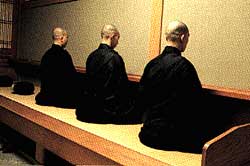Temple fare: The
threshold of meditation
The Korean Herald
Seoul --
What is the happiest moment of the day? Many people might say, "When I'm eating
delicious food." Could it be when you are eating sweet and savory foods? What happens
after we swallow? That moment of happiness does not stay for long, but disappears quickly.
 The great Korean
Buddhist master Seongcheol, who passed away seven years ago, ate only the minimum amount
of food necessary to sustain life, health and meditation. If even one gram too much was
served, he would notice the excess amount and leave it on the plate. It seems that he
didn't know or care about the joy of eating.
The great Korean
Buddhist master Seongcheol, who passed away seven years ago, ate only the minimum amount
of food necessary to sustain life, health and meditation. If even one gram too much was
served, he would notice the excess amount and leave it on the plate. It seems that he
didn't know or care about the joy of eating.
Buddhism's opinion
on the value and role of food differs from the secular view. As one sutra says, one should
eat only the minimum amount of food necessary to practice meditation properly, and the
food should not contain ingredients known to hinder one's concentration or wisdom. After
Sakyamuni's renunciation, he focused on ascetic practice for six years and excelled in it,
but it did not satisfy or enlighten him.
When Sakyamuni came
down to a village, a woman named Sujata served some rice gruel to him. Having eaten a
small amount of the nutritious food, Sakyamuni began meditating again and attained
enlightenment under the Bodhi Tree. The food he had was very soft and nutritious, which
helped him sit in meditation.
Recently, many
people have become interested in temple food, but it has already been 10 years since Ven.
Jeokmun started to research and publicize the benefits of Korean temple food, even though
many senior monks cautioned him against doing so.
"Before I
started to study our temple food, I surveyed the current cuisine offered in various
temples, and found that many monks and laymen did not realize the influence of temple food
on their practice and meditation," Jeokmun said. "So, I collected as much
information from the sutras as I could find, and studied for three years on why it is that
several foods are prohibited."
In the past, there
were strict rules on preparing and eating meals in the temples. Food was considered so
precious that if even a single grain of rice was left uneaten, the senior monk would get
angry and shout at the culprit to eat it.
"I always keep
three rules in mind when I cook," Jeokmun said. "One is to use only proper
ingredients, meaning no meat, no pickled fish, none of the five most fragrant vegetables
(garlic, onion, green onion, and two wild vegetables), and so on. Another is to make
something that, in the end, has a soft and mild taste that is not too salty or spicy, so
as not to burden the stomach. The third is to observe the right order of cooking so that
each seasoning will produce its own flavor in the food. But the most important thing in
preparing the dishes is that we calm our minds and wear a formal robe (to show respect)
before we start."
Jeokmun believes
that many laypeople can understand Buddhism better through temple food, because they can
learn about temple-style dishes and discover cures for modern diseases from them. These
benefits explain why, when Jeokmun opened the Cultural Institute of Traditional Korean
Temple Food and started his series of lectures, he received a lot of attention from
laypeople and even followers of other religions.
"Currently,
the concept of temple food is ambiguous, but we can better understand the wisdom of our
traditional temple food through continuous study and deep research. I really want to let
everyone know about the right way of cooking and provide insightful information on
ingredients, so that it can be helpful for many monks in their practice," he said.
Jeokmun
communicates with laypeople through food, and meditates when he cooks: Cooking, one can
say, is his way of spiritual practice.